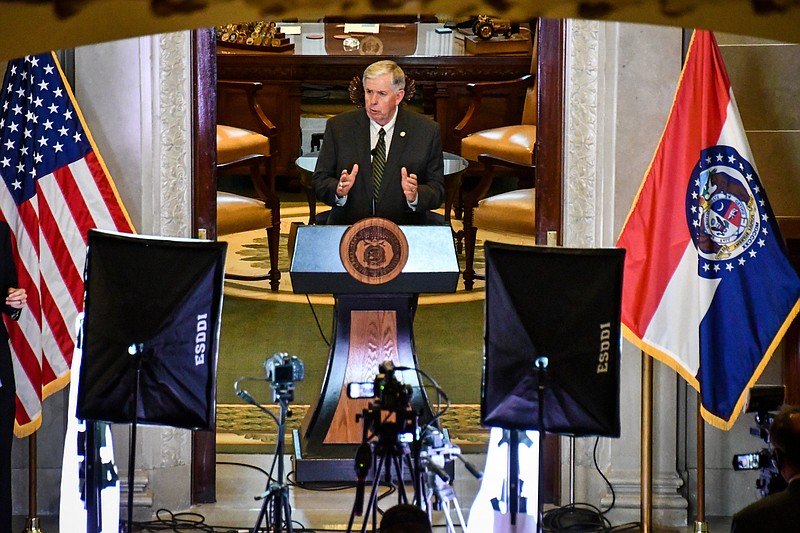On the first day of the phased reopening of the state, Missouri Gov. Mike Parson on Monday extended some executive orders he signed earlier during the COVID-19 pandemic, including those authorizing relaxed regulations and the deployment of the Missouri National Guard.
Meanwhile, State Treasurer Scott Fitzpatrick said federal aid money to local governments began to be distributed Monday, though counties need to have submitted their paperwork to be eligible, and some including a Mid-Missouri county have not yet done that.
Missouri's reopening will be a lengthy process, with the new public health order guiding the first phase of reopening in effect through at least May 31.
Parson spent the morning visiting businesses and a hospital in Joplin and Springfield.
He announced during his afternoon briefing at the State Capitol that he has extended four of his executive orders to June 15 - to match the length of Missouri's current state of emergency.
The state of emergency allows for powers to use and deploy resources and temporarily waive or suspend regulations, and one executive order authorizes the waiving or suspension of any law or regulation for state business that compliance with would limit the state's ability to respond to the pandemic.
Another order authorizes restaurants to sell un-prepared food directly to members of the public, food that might otherwise go to waste for lack of customers.
Under previous public health orders, restaurants had been limited to curbside, delivery, drive-thru or takeout service - though dine-in service could resume Monday, with social distancing measures in place.
Parson also extended the orders allowing the state to involve the Missouri National Guard in the response to the pandemic. The Guard's activities have included health screenings at public buildings, staffing a hospital overflow site and distributing food to school children - and allow for remote notary public services.
"I think the next two weeks are really critical," Parson said of how success of reopening will be measured, including by how many people abide by continued social-distancing orders and what data shows regarding trends in infection.
Parson and Dr. Randall Williams, director of the Missouri Department of Health and Senior Services, attributed another large jump in the overall total of cases in the state since the beginning of the pandemic to focused testing at a meat plant.
Williams said the peak of community transmission in the state was around April 6-7.
Parson was encouraged that of approximately 3,000 random tests over the weekend across the state, only nine came back positive.
Williams said there will soon be a website available that expands upon the data the state provides daily on infections and deaths, which will better show the downward trend in infections the state is using as evidence it's prepared to reopen.
As of Monday afternoon, since the first reported case of COVID-19 in Missouri on March 7, the state has had 8,753 further reported cases - out of more than 92,000 people tested - with 358 deaths, according to DHSS.
"People are still going to get sick, and some people are going to die," but the state has to reopen the economy and continue to fight the virus at the same time, Parson said.
Meanwhile, Fitzpatrick said approximately $468 million in emergency federal funding had been processed for 105 counties and the city of St. Louis.
The money is being distributed by the state through the federal Coronavirus Aid, Relief, and Economic Security Act, or CARES Act.
The $468 million is part of more than $520.9 million to be disbursed to counties to help cover pandemic emergency response expenses, such as medical or public health needs, as well as expenses related to addressing unemployment and businesses' interruptions.
Fitzpatrick said counties should have access to the money in their accounts by Wednesday - in a single large payment - though seven counties had not submitted the certification form necessary for Fitzpatrick's office to have in order to receive payment.
Osage County is the only Mid-Missouri county that hasn't submitted documentation; the county stands to receive almost $1.6 million.
The funds are being allocated based on population.
Fitzpatrick said counties have been instructed to keep records of what they use the funding for because the federal government will do an audit, and if any money is used improperly it will be recovered.

